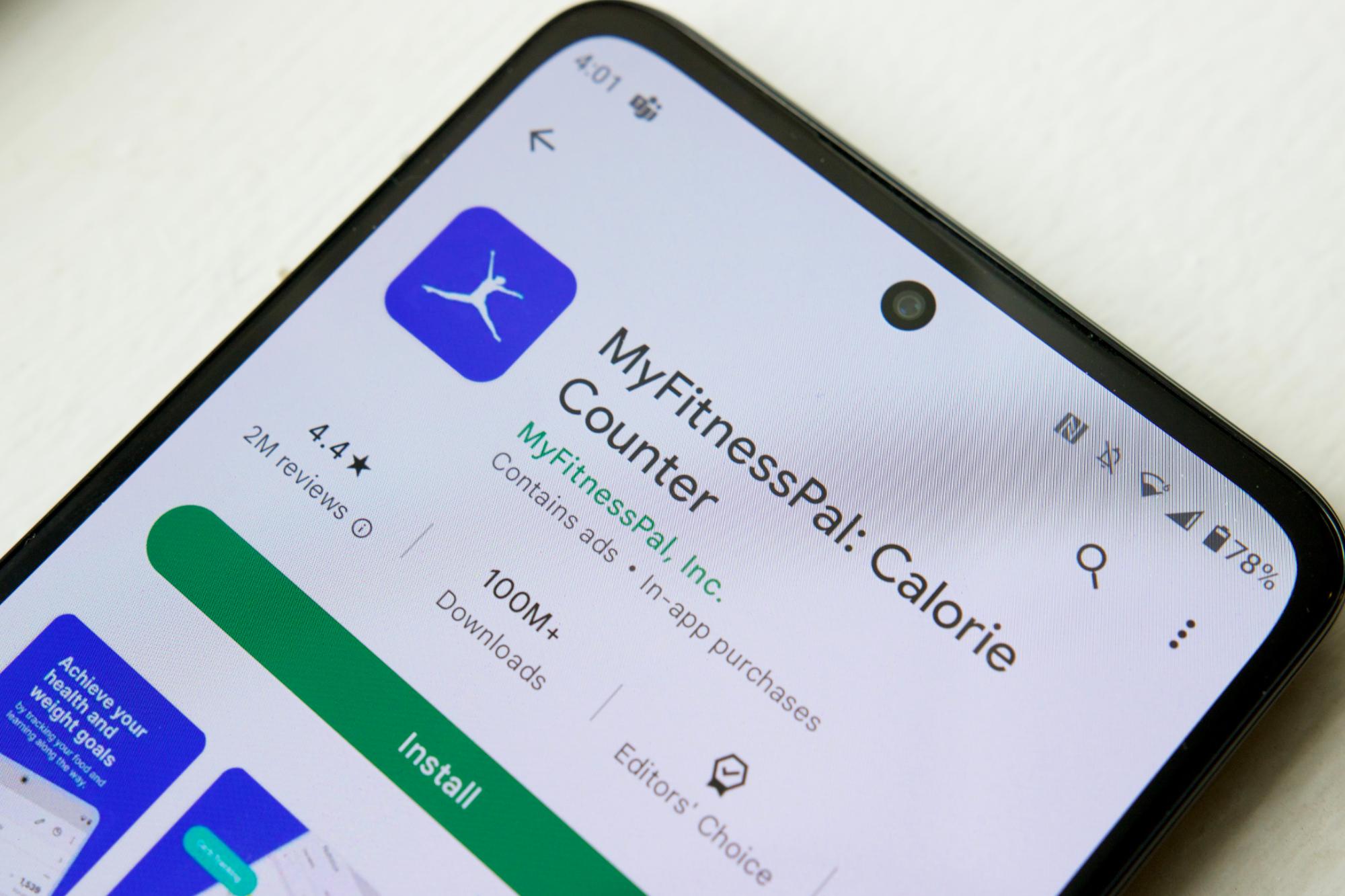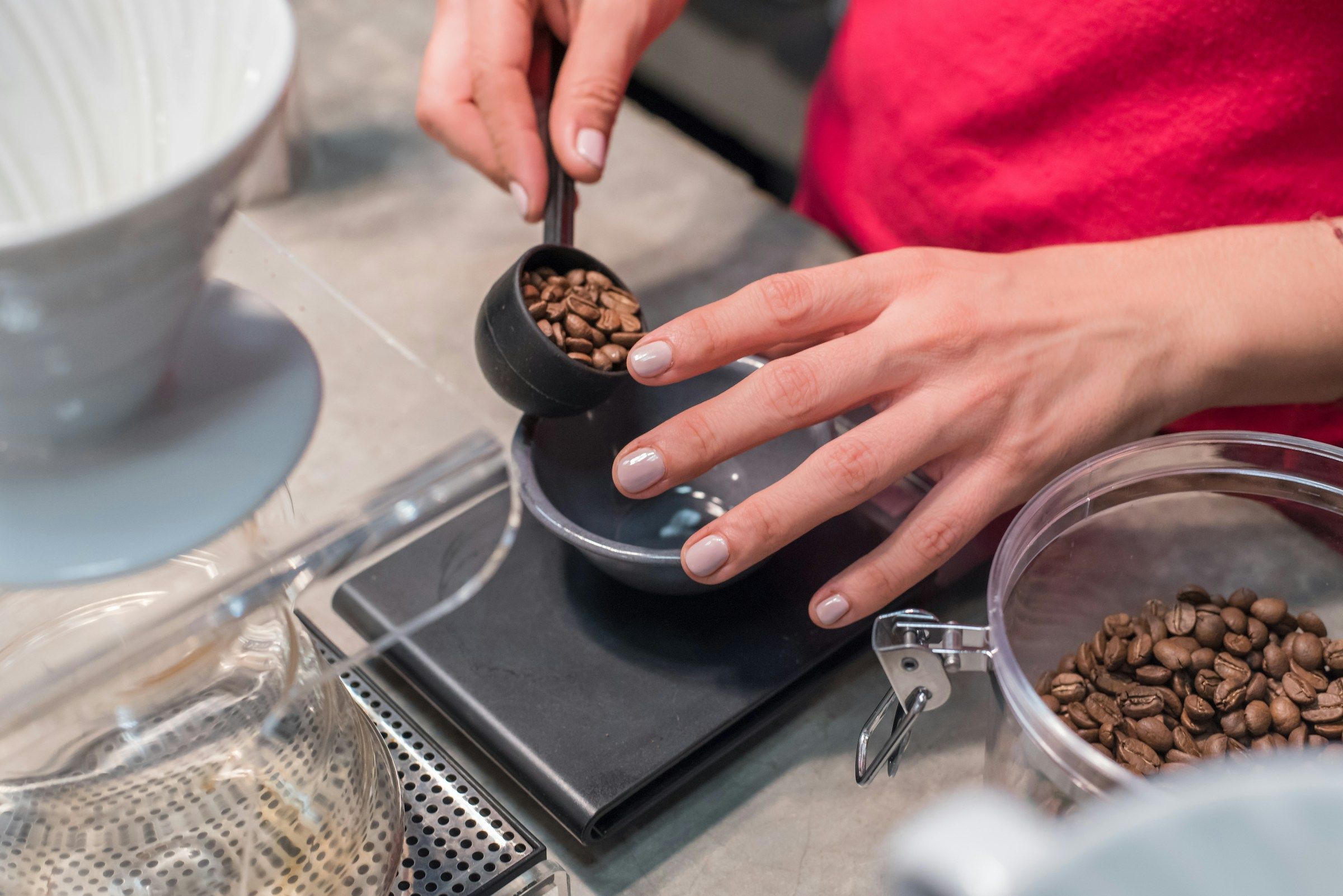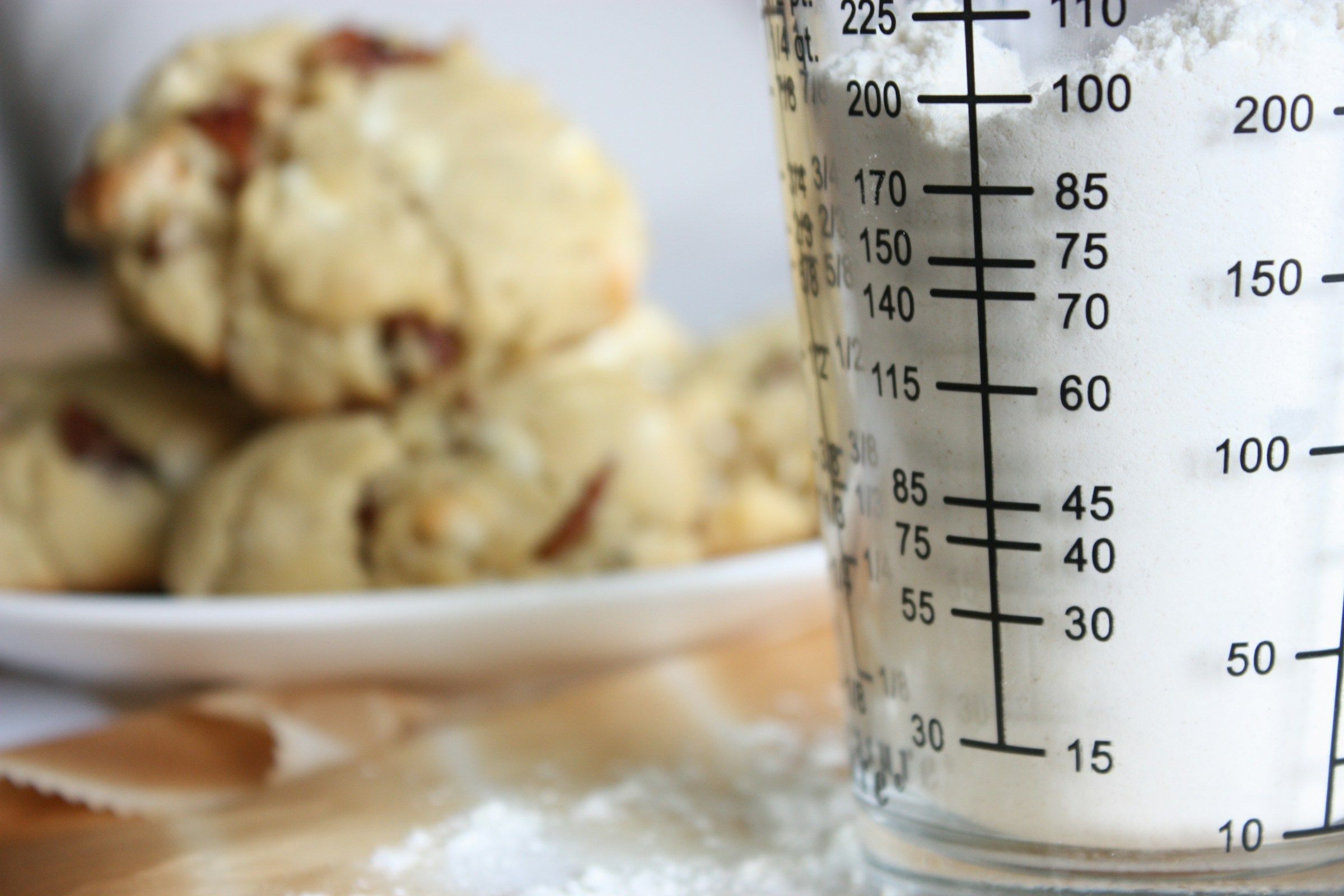Keeping track of calories can be a chore. To make it easier, many people turn to calorie-tracking apps. With so many options available, picking the right one can be tricky. For example, MyFitnessPal and Cronometer are best apps to track macros. They have different strengths and weaknesses. This article will help you confidently choose MyFitnessPal vs. Cronometer for accurate and reliable calorie tracking.
Goldi AI’s calorie tracker can help you achieve your goals, whether you pick MyFitnessPal, Cronometer, or another app. Goldi AI’s tool will allow you to track your calories and macros accurately and reliably without the hassle.
What is Nutrition Tracking and How to Do It

Nutrition tracking means recording what you eat and drink to understand your dietary habits. The purpose of tracking your nutrition is to identify areas for improvement so you can manage your:
- Health
- Fitness goals
- Dietary intake
The basic process of tracking nutrition involves the following:
- Logging foods and drinks consumed
- Noting portion sizes
- Analyzing the nutritional content
Apps and tools make it easy to track your intake accurately. Periodically tracking your food intake can be a helpful way to identify areas where there is room for improvement in your daily habitual diet. I recommend most of my clients do it as a starting point before making any changes, and I’ll occasionally record myself every couple of months. It’s worth noting that there are many errors in food assessment.
The Limitations of Nutrition Tracking Apps: Accuracy, Personalization, and When to Use Them
Errors in estimating your food portions, errors in the nutritional composition of the foods you add —no app is perfect—and the data you receive is ONLY as good as what you enter. Numbers are very individual—what is ideal for one person could differ significantly from what is perfect for you.
Always take any numbers with a grain of salt—anticipating that you could be anywhere from 10-20% over or underestimating your intake. My opinion regarding nutrition tracking is that it is not for everyone. I wouldn’t advise using it daily, but it can be convenient to see where improvements can be made.
What are Effective Ways to Track Food Intake?
There are three main ways where you can do some form of nutrition tracking, namely:
- Writing down a list of the foods eaten each day
- Taking photos of the foods, drinks, and snacks
- Using an app to record your food intake
The last option—using an online app to help record your food intake—is the nutrition tracking strategy I will focus on today. I’ll compare two of the most popular apps, Cronometer and MyFitnessPal.
What Is MyFitnessPal and Why Is It So Popular?
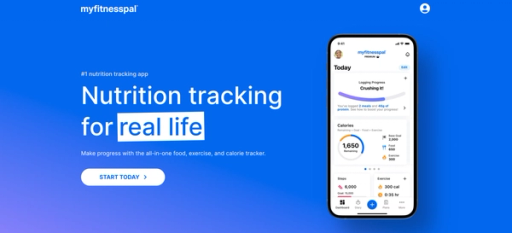
MyFitnessPal is a nutrition app that helps you pursue weight loss or weight gain goals that track:
- Calories
- Macronutrients
- A few micronutrients
- Water intake
- Exercise
- A selected number of measurements
MyFitnessPal is one of the most popular apps for tracking calories and macros, with a database of over 11 million foods. While MyFitnessPal was one of the first popular diet apps, it now has:
- Fewer details
- Customizations
- Features than many other apps on the market
Customizing Calorie and Macronutrient Targets in MyFitnessPal: Free vs Premium Features
During the intake process, MyFitnessPal records basic data about the user to suggest a calorie target, such as:
- Age
- Height
- Current weight
- Goal weight
- Activity level
Users can accept or override this target and set targets for the percentage of calories they want from each macronutrient (to the nearest 5%). Premium users can set specific targets in terms of grams.
Maximizing Food Tracking in MyFitnessPal: Using the Database, Barcode Scanner, and Meal Creation Features
You can search the food database or pay a premium to use the barcode scanner to track food. Users can also create recipes or meals by saving groups of ingredients that are commonly eaten together.
There is an option to “complete” the diary, which will show a projected weight in 5 weeks, assuming every day was the same as the completed day.
Pros of Using MyFitnessPal
- Intuitive and easy-to-understand interface
- Covers essential calorie and macro-tracking needs
- Global database with millions of entries, including foods from chain restaurants
Cons of Using MyFitnessPal
- Only six micronutrients are tracked
- Many inaccurate entries in the database
- Full-page ads and pop-ups make the free version slow to use
- The Barcode scanner is only in the premium paid version
What is a Cronometer and Why Is It a Serious Contender?
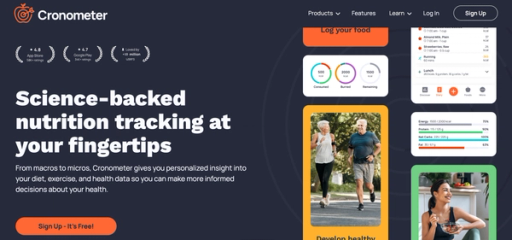
Cronometer stands apart in nutritional apps to optimize your health. It tracks:
- Calories
- Macronutrients
- Micronutrients
- Water intake
- Many biomarkers, including:
- Measurements
- Sleep
- Mood
- Lab results such as blood tests or blood pressure
Cronometer allows you to track your daily food intake against customizable targets for:
- Calories
- Macronutrients
- Micronutrients
This can help you meet your goals for:
- Weight loss
- Weight gain
- Managing a health condition
Leveraging Cronometer’s Reports for In-Depth Nutritional Tracking and Analysis
Cronometer offers many reports, including a detailed daily summary showing micronutrient intake against recommended daily values. You can also generate custom reports to compare variables or track desired items over time.
The Good And Bad Of Using a Cronometer
Pros
- Customizable energy settings
- Verified database
- Detailed, extensive micronutrient information
- A comprehensive library of biomarkers
- Standardized and custom reports
- Recipes include Notes for instructions and can be shared with friends
- Community support
Cons
- Calorie counts don’t display in search results until you click on the entry
- There is no grouping of foods into meals/snacks in the free version; all foods appear in one big list
Head To Head Myfitnesspal vs. Cronometer Comparison

Food Database: The Heart of Nutrition Tracking Apps
The food database in Cronometer features only verified entries. Data is sourced from:
- The USDA
- Nutrition Coordinating Center
- Verified user entries
While Cronometer’s database predominantly features North American foods, international entries are slowly being added. MyFitnessPal, on the other hand, boasts millions of entries from around the world. Most data comes from user-generated content, so it isn’t very accurate.
Choosing the Right App for Eating Out: MyFitnessPal vs. Cronometer for Tracking Chain Restaurant Nutrition
The app does feature entries from chain restaurants based on published nutritional data, which can be helpful. While Cronometer’s database is more accurate, it won’t help if it doesn’t have entries for the foods you’re looking for. For this reason, MyFitnessPal is helpful for travelers or those who eat out often.
**The Winner: Tie
Advanced Tracking Capabilities: Go Beyond Food Logging
Cronometer allows users to track everything about their health. In addition to logging food—where Cronometer captures calories, macronutrients, and micronutrients—you can also track:
- Water intake
- Exercise
- Sleep
- Mood
- Lab results
You can even create custom measurements for any health metric you want to track.
MyFitnessPal also tracks:
- Food
- Calories
- Macronutrients
- Limited micronutrients
- Water intake
- Steps
- Exercise
- A pre-set list of measurements
- Weight
- Body fat
- Neck
- Waist
- Three hip circumference measurements
**The Winner: Cronometer
Calorie Recommendations: Getting You On Track
Calorie recommendations in Cronometer are adjustable and can even be overridden entirely if you are working with a nutrition coach or registered dietician who has provided targets for you. With so many options to adjust basal metabolic rate and activity level to estimate your total calories burned, Cronometer can provide a much more accurate recommendation to meet your stated weight goals (whether to lose, gain, or maintain). You can also set macronutrients to the exact number of grams that you want.
MyFitnessPal’s recommendations are less customizable than Cronometer’s, although you can still override them entirely if needed. My biggest frustration with MyFitnessPal was that macronutrient targets can only be set to the nearest 5% in the free version, so I had to pay for premium to be able to set the exact grams I wanted.
**The Winner: Cronometer
Level of Customization: Tailor the App to Your Needs
Cronometer’s customization options go beyond setting calorie and macronutrient targets (discussed above). You can also customize your dashboard for what you see:
- Do you want to see a summary of calories burned?
- What macronutrients do you want/not want to display?
Then, you can create:
- Custom reports
- Graphs
- Charts
Maybe your doctor told you to increase magnesium intake to improve your sleep. You can create a chart to show magnesium intake and sleep levels over time to see if there is an improvement.
MyFitnessPal offers less customization regarding calories and macronutrients (as described above), and all the reports, graphs, and charts are pre-designed. You cannot customize the options.
**The Winner: Cronometer
Education Opportunities: Learn While You Track
Cronometer’s “Ask the Oracle” feature is one of my favorite app parts. I wasn’t previously paying attention to my micronutrient intake because I didn’t have the data to do so in MyFitnessPal. When I started looking at my daily report in Cronometer, I realized I was routinely low on phosphorus intake.
The “Ask the Oracle” feature allowed me to find out what foods were the best sources of phosphorus to increase my intake without a dedicated supplement. So, not only does Cronometer teach you about the calorie count and macronutrient breakdown of different foods for given serving sizes, but you can also learn about micronutrient content AND what foods are the best sources of given micronutrient.
Debunking Food Myths with MyFitnessPal: Understanding Nutritional Content Beyond Diet Labels
MyFitnessPal deserves credit for helping me understand the nutritional content of my foods in terms of calories and macronutrients. Before I started tracking macros, I felt a lot of confusion about foods labeled by the diet industry as “good” or “bad.” I did not realize that there was nothing magical about so-called “good” foods that would guarantee weight loss.
For example, raw unsalted nuts are a source of “healthy fat,” but they are also very calorie-dense and easy to overeat. MyFitnessPal showed me that 100 g of nuts has nearly 600 calories and 60 g of fat. A Snickers bar is about 500 calories for 100 g and only 22 g of fat.
**The Winner: Cronometer
Coaching: Support for Your Health Journey
Cronometer doesn’t have its coaches on staff like Noom (click to read my review). Still, Cronometer has a membership called Chronometer Pro, which is specifically for health professionals like coaches or dieticians to use with their clients.
In Cronometer Pro, the coach gets a dashboard view to monitor clients’ intake and can communicate with clients directly through the app. The coach can also share recipes with clients to give them healthy meal options or to hit a specific macronutrient or micronutrient goal.
Coaching Integration: Comparing MyFitnessPal’s Diary Sharing to Cronometer Pro’s Dashboard
MyFitnessPal doesn’t provide any opportunities for users to work with a coach. Some coaches ask their clients to use MyFitnessPal and turn on diary sharing so that the coach can see the intake as a “friend,” but this isn’t the same level of visibility as the Cronometer Pro dashboard.
**The Winner: Cronometer
Recipe Database: Find Meal Ideas to Hit Your Goals
Cronometer does not have a recipe database that users can search for; it only has the recipes they input themselves or share with friends (in the Gold version). MyFitnessPal has a “Recipe Discovery” feature that allows users to search for recipes based on category or hashtags (such as “Immune Support” or “vegetarian”).
Premium users can even import a serving of the recipe into their diary (this would only be accurate if they made the recipe with the exact ingredients and amounts noted in the original recipe).
**The Winner: MyFitnessPal
Exercise Calories: How Do They Impact Your Goals?
When you log exercise in a nutrition app or when your exercise syncs into the app from a connected device like a Fitbit, the app estimates how many calories you burned while doing that exercise. Some apps automatically add these estimated calories to your daily total.
But, you may not want that: your daily total might already include an amount for activity, or you might want to keep a lower daily target so that your exercise creates a calorie deficit for weight loss.
Exercise Calorie Management: Cronometer vs. MyFitnessPal for Tracking and Customization
I’ll cover what each app does with exercise calories: Cronometer has two settings related to exercise calories: Users can import “activity calories” from activity trackers like FitBits or Apple Watches and can use these activity calories instead of a calculated “activity multiplier” that is used in estimating total calories burned for the day (TDEE: total daily energy expenditure).
Users can also decide whether exercise calories should be added to their total daily calorie target or ignored. MyFitnessPal only has settings related to exercise calories, not activity calories, and the ability to choose what to do with exercise calories (ignore them or add them to daily targets) is limited to premium users.
**The Winner: Cronometer
Price: Free vs. Paid Versions
Cronometer has all of the features I’ve described in the free version. The only things not included are recipe sharing and the ability to log foods in separate meals. These two features exist only in Cronometer Gold. A Cronometer Gold membership costs $49.99/year, less than $5 per month.
MyFitnessPal has been moving more features and functionality to its paid Premium version. The barcode scanner (free for years) was moved to a paid feature in October 2022. A MyFitnessPal Premium membership is $79.99/year or $19.99/month for a month-to-month subscription).
**The Winner: Cronometer
Reviews: What Are Users Saying?
In the Apple App Store, Cronometer has 4.7 / 5 stars from over 39 thousand reviews. Many recent reviews talk about how happy users are when they switch from MyFitnessPal (like me). MyFitnessPal has 4.2 / 5 stars from over 2.5 million reviews. The app has been around longer, so many more downloads and reviews exist.
Amazingly, MyFitnessPal has rated 4.7 / 5 stars based on 1.5 million reviews in November 2022. That means in two months of reviews, the rating dropped 0.5 stars. With so many reviews, nearly all recent reviews would have to be negative. This can be seen in the comments from recent reviews, where users complain about missing previously free features and slower performance due to ads.
**The Winner: Cronometer
Track Your Calories within Less Than 15 Seconds with Our Calorie Tracker App
Goldi AI transforms calorie tracking with cutting-edge AI technology. Just snap a photo of your meal, and we’ll do the rest.
Our app combines your phone’s depth sensor with advanced AI models to:
- Analyze food volume
- Identify ingredients
- Instantly calculate calories, protein, carbs, and fat content
With 90% accuracy on visible foods and multiple tracking options like:
- Barcode scanning
- Food label recognition
- Manual descriptions for complex items like smoothies
We’ve made nutrition tracking effortless. Whether you’re scanning a full meal or a quick snack, Goldi AI
- Provides nutritional information in under 15 seconds
- Eliminates the need for tedious manual logging.
Our AI learns from your feedback to improve accuracy. It includes personalized insights and smart reminders to keep you on track. Goldi AI makes achieving your fitness goals simpler than ever.
Track your calories with your camera using Goldi AI’s calorie tracker today!
